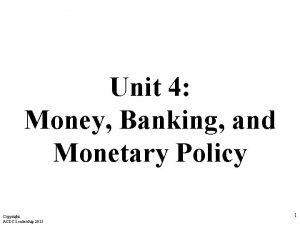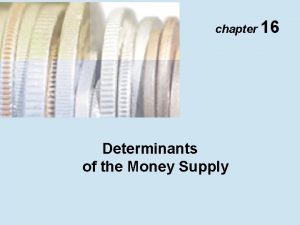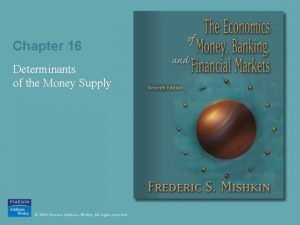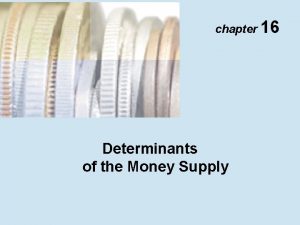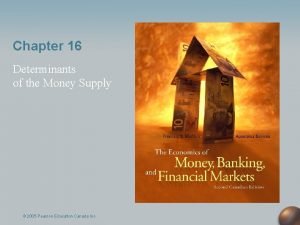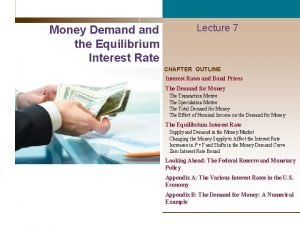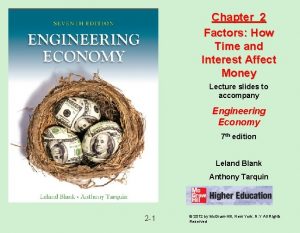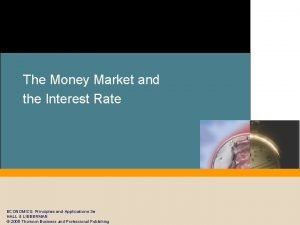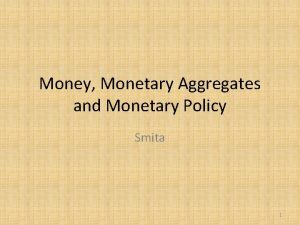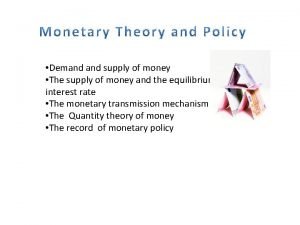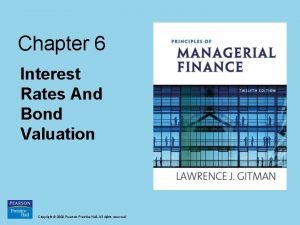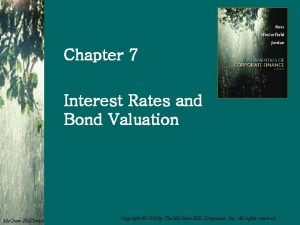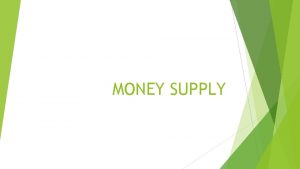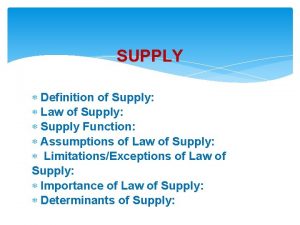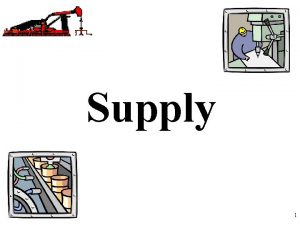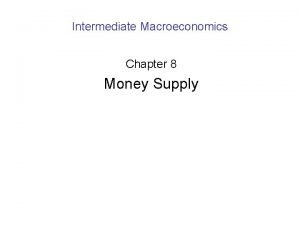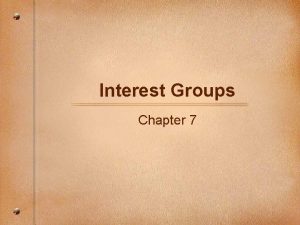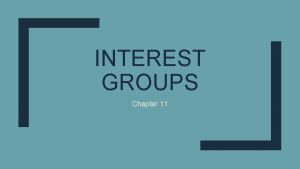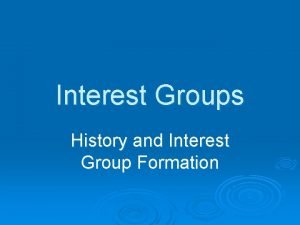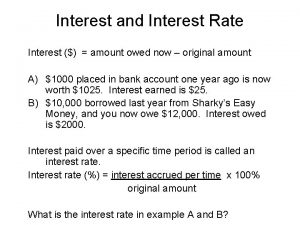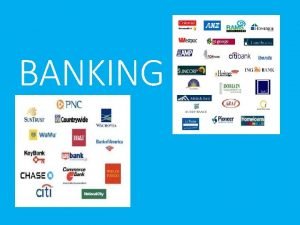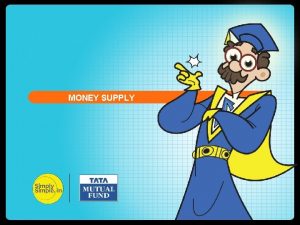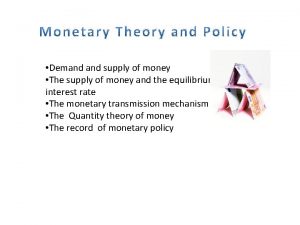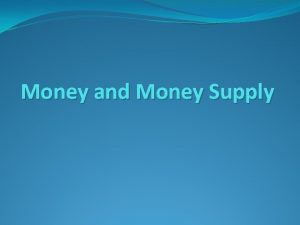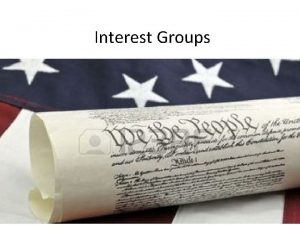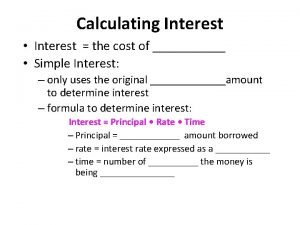Chapter 2 Money Money Supply and Interest Money






















- Slides: 22

Chapter 2 - Money, Money Supply, and Interest Money and Banking – Michael Brandl © 2017 Cengage Learning

2 -1 The Concept of Money Just what is money? Money does, in fact, make the world go around. How? Why do interest rates exist? The Value of Money – Value today we will receive in the future vs. the value in the future vs that we have today. Money and Banking – Michael Brandl © 2017 Cengage Learning

2 -1 a Money Defined “Generally accepted” in exchange for goods and services Russian Ruble Crisis of 1999: people stopped using the official ruble in exchange for goods and services. Are currencies are considered money all the time? NO Money and Banking – Michael Brandl © 2017 Cengage Learning

2 -1 a Money Defined (continued) Ø Currency substitution – Use of another country’s currency in private transactions. Ø The local currency remains legal tender and continues to circulate Ø Legal Tender – Paper money is a valid and legal means of payment of any debt that was contracted in dollars Ø the Coinage Act of 1965, specifically Section 31 U. S. C. 5103, entitled "Legal tender, " which states: "United States coins and currency (including Federal reserve notes and circulating notes of Federal reserve banks and national banks) are legal tender for all debts, public charges, taxes, and dues. “ No compunction to accept though…. “Official semi-dollarization” – another country’s currency is legal tender, but the country also issues its own currency. Money and Banking – Michael Brandl © 2017 Cengage Learning Ø

2 -1 b Functions of Money Medium of exchange Medium of Exchange – usable for buying and selling goods and services. Money allows society to escape the complications of barter. Money enables society to gain the advantages of geographic and human specialization Money and Banking – Michael Brandl © 2017 Cengage Learning

Unit of Account Society uses monetary units – As a yardstick for measuring the relative worth of a wide variety of goods, services and resources. We gauge the value of goods in dollars Money aids rational decision making by enabling buyers and sellers to easily compare the prices of various goods, services and resources. Money and Banking – Michael Brandl © 2017 Cengage Learning

Store of Value Enables people to transfer purchasing power from the present to the future. People do not spend all of their income on the day they receive it. To buy things later, they store some of their wealth as money. Money does lose its store of value. Inflation reduces the “purchasing power” of money. Money and Banking – Michael Brandl © 2017 Cengage Learning

Standard of Deferred Payment Money is used to settle obligations into the future and therefore to write contracts going forward in time This function holds if the previous 3 properties hold

2 -2 a Money Supply The Amount of Money Matters Inflation occurs due to the money supply grows too quickly. When the money supply increases too quickly, there is too much money chasing too few goods. If the money supply does not grow fast enough, there is not enough money for transactions to take place. Economy could slide into a recession or even worse a depression. Money and Banking – Michael Brandl © 2017 Cengage Learning

2 -2 b Characteristics of Money For any asset to function as money, the following must be met: Easily standardized so prices of two units can be compared [“Standardizability” Divisible [“Divisibility”] Portable [“Portability”] Physically durable [“Durability”] Recognizable Broadly [“Recognizability”] demanded in society Money and Banking – Michael Brandl © 2017 Cengage Learning

What has functioned as money over time? Cigarettes: Standardized – contained the same amount of quality of tobacco Easily divisible – 20 in a pack, “making change” was straightforward Portable Long self life, as long as kept dry Always Nazi – easy to carry around in demand POW camps: cigarettes were money Money and Banking – Michael Brandl © 2017 Cengage Learning

Other Commodity Money Russian Rouble Crisis of 1999 - people used different forms of commodity money, turned away from using the ruble. In 1998, 50% to 75% of “exchange in industry” – some type of commodity money, including Russian Vodka Currency issued by a country’s government has a direct relationship with that country’s function of money. Money and Banking – Michael Brandl © 2017 Cengage Learning

Challenges with Commodity Money Two widely used types through time: Gold Silver Enough in circulation meets the transaction needs of the people NOT enough in circulation could slide a country into recession or an economic depression If the supply increases too rapidly (e. g. due to new discoveries), it triggers inflation (too much money chases too few goods)

Fiat money vs Commodity money – value as money is the same as value as a commodity Fiat money – value as money is different from value as a commodity e. g. Gold coin is commodity money if its value as a gold coin is the same as the value of the gold that goes into the coin. Our currency ( = notes and coins) is fiat money as: 1 cent costs more than one cent to produce (so US mint makes a loss) $1 note costs less than $1 to produce (so Federal Reserve makes a profit) Profits and losses from production of money are called “Seigniorage”

Seigniorage of US mint Source: https: //www. usmint. gov/wordpress/wp-content/uploads/2018/01/2017 annual-report. pdf

Money Definition M 1 and money supply M 2 M 1 – The narrowest definition of the money supply is M 1 It consists of two components: Currency (coins and paper money) in the hands of the public All checkable deposits: all deposits in commercial banks and “ thrift” or savings institutions on which check of any size can be drawn Money, M 1 = currency + checkable deposits Money and Banking – Michael Brandl © 2017 Cengage Learning

Money Definition M 2 M 1 + savings deposits, including money market deposit accounts + small – denominated (less than $100, 000) time deposits + money market mutual fund held by individuals Money and Banking – Michael Brandl © 2017 Cengage Learning

2 -4 a Time Value of Money Greatly prefer current consumption to future consumption; you have “high time preference” If you are indifferent between consuming now or in the future, you have a “low time preference”. Deferring your consumption to the future (something you don’t want to do), I have to compensate you. The compensation is called interest. The higher your rate of time preference, the higher rate I must pay you to defer your consumption. Money and Banking – Michael Brandl © 2017 Cengage Learning

2 -4 b Present Value Someone lends you $1000. 00 for one year. You are asking that person to defer their consumption for one year, so this person will want to be compensated. $100. 00 of interest on the loan, or 10% Payback at the end of the year = $1, 100 Money and Banking – Michael Brandl © 2017 Cengage Learning

2 -4 b Future Value Nominal value of an asset, at some point in time in the future. The concept of time value of money from a saver’s perspective See example in this section of the book: at the end of 15 years you would have $22, 203. 66 Money and Banking – Michael Brandl © 2017 Cengage Learning

Compounding vs Discounting With compounding, you pay someone into the future for deferring consumption now $1 becomes $1. 05 next year if the interest rate is 5% Then $1 x(1+0. 05) in year 2 If you do the opposite (bring consumption in the future back to the present), you are said to discount. $1 a year in the future becomes $1/(1+0. 05) = $0. 952 now

Summary Definition of Money Barter Functions of money Commodity money Fiat money Seigniorage Money Supply Monetary Aggregates Time Value of Money
 Decreasing money supply
Decreasing money supply Chapter 5 section 1 supply
Chapter 5 section 1 supply What is real interest rate and nominal interest rate
What is real interest rate and nominal interest rate Simple interest
Simple interest Money money money team
Money money money team Effective rate
Effective rate Chapter 16 determinants of the money supply
Chapter 16 determinants of the money supply Chapter 16 determinants of the money supply
Chapter 16 determinants of the money supply Chapter 16 determinants of the money supply
Chapter 16 determinants of the money supply Deposit multiplier
Deposit multiplier Money demand and interest rate
Money demand and interest rate How time and interest affect money
How time and interest affect money Matching supply with demand
Matching supply with demand Money market supply and demand
Money market supply and demand Money supply and credit creation
Money supply and credit creation Money supply and demand graph
Money supply and demand graph Pagbabago sa dami ng supply at pagbabago sa supply
Pagbabago sa dami ng supply at pagbabago sa supply Chapter 7 interest rates and bond valuation
Chapter 7 interest rates and bond valuation How to find the price of a bond
How to find the price of a bond Chapter 6 interest rates and bond valuation
Chapter 6 interest rates and bond valuation Chapter 7 interest rates and bond valuation
Chapter 7 interest rates and bond valuation Chapter 6 interest rates and bond valuation
Chapter 6 interest rates and bond valuation What exactly is money
What exactly is money
